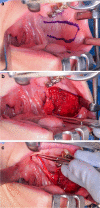Pedicled buccal flaps as a backup procedure for intraoral reconstruction
- PMID: 35072841
- PMCID: PMC9938028
- DOI: 10.1007/s10006-022-01040-7
Pedicled buccal flaps as a backup procedure for intraoral reconstruction
Abstract
Background: Intraoral soft tissue deficiency and impaired wound beds are common problems after cleft and tumour surgery or after dental trauma. Frequently, limited defects are overtreated with extensive microvascular reconstruction procedures, but pedicled flaps remain useful, as they are simple to harvest, and they provide a reliable outcome. The buccal flap, first described in the 1970s, has been used for palatine lengthening in cleft patients over decades. In the following, we present an expanded indication in cases of palatal fistula, complex vestibulum, exposed bone in orthognathic surgery, and osteoradionecrosis.
Methods: We conducted a retrospective chart review and report on all buccal flaps harvested in our department within the last 3 years with a follow-up period of at least half a year after flap surgery. Patients of all age groups and treatment indications in which a buccal flap was used were implicated in the evaluation.
Results: Sixteen buccal flaps were performed in 10 patients. The median age at the time of surgery was 42 years, reaching from 12 up to 66 years. Fourteen buccal flaps were used for upper jaw or palatal coverage; two buccal flaps were used in the mandible. In terms of complications (four flaps; 25%), there were two partial flap failures, one wound dehiscence and one wound dehiscence. There were no failures of the remaining mucosal flap islands after pedicle dissection.
Conclusion: The buccal flap is a reliable and straightforward approach to challenging intraoral wound beds with soft tissue deficiency. We thoroughly discuss the additional indications for buccal flap surgery, describe the harvest technique, and provide strategies to prevent intra- and postoperative complications.
Keywords: Backup procedures; Cleft surgery; Oral surgery; Pedicle flaps; Reconstructive surgery.
© 2022. The Author(s).
Conflict of interest statement
The authors declare no competing interests.
Figures



References
-
- Axhausen G. Über den plastischen Verschluss von Antrum-Mundhöhlen-Verbindungen. Dtsch Monschr f Zahnheilkunde. 1930;3:193–204.
-
- Rehrmann A. Eine Methode zur Schliessung von Kieferhöhlenperforationen. Dtsch Zahnärztl Wschr. 1936;39:1136.
MeSH terms
LinkOut - more resources
Full Text Sources
Medical

